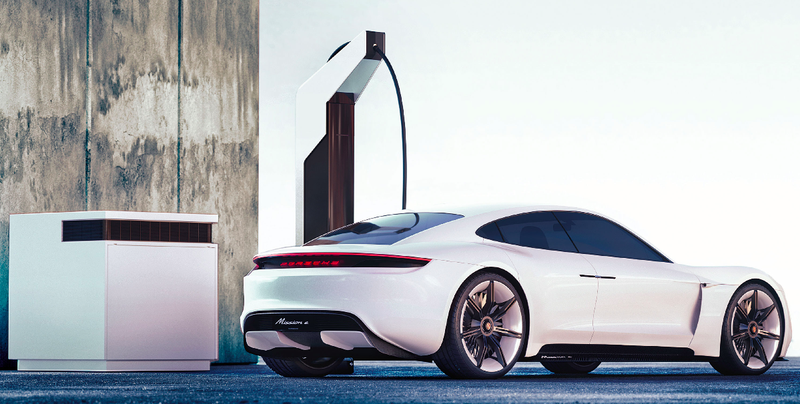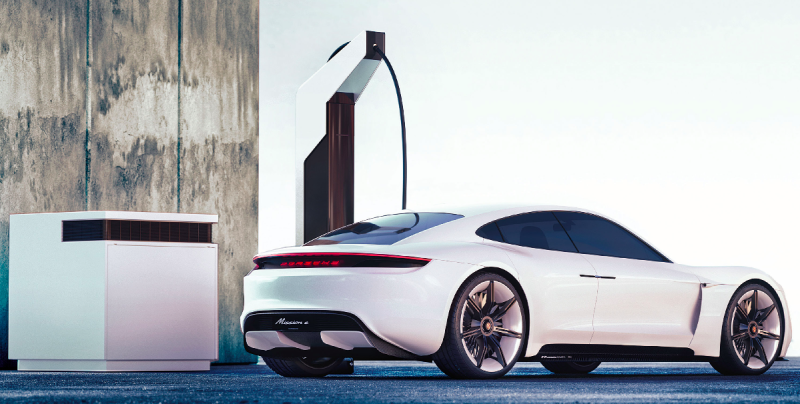
Yesterday, Porsche showed off its new electric vehicle charging station architecture, which involves breaking up a number of tasks that might normally all be done within a single charging “cabinet” into rectangular modules and slim charging poles. Here’s how it works.
We’ve known about Porsche’s 800 volt charging stations—which the company is rolling out in addition to its upcoming electric sedan, the Taycan—since earlier this summer. But now the brand has revealed some details on how its chargers are set up.
Porsche says on its website that one of the main features of its newly developed “charging park system” is the modularization of tasks normally all included in a single cabinet—things like galvanic isolation, power electronics duties, cooling, connectivity, and transformer duties.
Forcing all of these functions into a single cabinet, Porsche says, makes each individual station too expensive. That’s why Porsche’s breaking up some of these tasks into roughly four-foot cubes called FlexBoxes. Porsche describes some of the benefits:
So both visually and in terms of noise, [the FlexBoxes] are hidden from the customer…The modules can be positioned wherever there is space, while the slim and user-friendly charging poles are optimally positioned for use by customers.
Advertisement
This clever packaging, Porsche says, makes it easier to install a charging system in various locations with different spacial constraints. The brand also says an advantage for medium size “charging parks” using this charging setup is the ability connects to medium-voltage power grids up to 36000 volts, which can yield quicker charging.
Among the FlexBoxes is something called a PowerBox, whose job it is to turn AC power from the transformer station into DC current. Porsche says this box can supply multiple charging points, even ones that are over 300 feet away, and it can be stored up to about 660 feet away from a transformer.
The next “FlexBox” is the CoolingBox, which keeps the liquid cooled charging poles and power electronics at optimal temperatures at all times. Porsche says its vision is for these CoolingBoxes to be far enough away from charging poles so that customers don’t hear cooling noises (fans). Porsche also says it will offer a “ComboBox,” which will include both cooling and transformer functions in a small package for areas where space is limited, like in a parking garage.
Advertisement
As for when there’s limited access to the medium voltage grid, Porsche says it will offer a ChargeBox, which will have a “buffer” battery in it that gets charged when there’s no vehicle plugged in, allowing for fast vehicle charging. Porsche describes where it sees such a setup being used:
The ChargeBox is ideal for locations with a low charging frequency per day and in situations in which an expansion of grid capacity would be expensive. The ChargeBox is available as an entry-level model with a 70 kWh battery and a 160 kW charging station.
For more highly frequented locations, for vehicles with higher charging capacities or as a subsequent retrofit, there is also a fully equipped version with 140 kWh and two 160 kW charging stations, combinable for 320 kW.
Advertisement
The brand also discusses the charging poles—the part of the charging system that users interface with:
As the engineers removed everything from the charging station that wasn’t absolutely required at the customer touchpoint and packed it into FlexBoxes, a streamlined appearance could be achieved…The crane-like shape of the poles is no coincidence: The high-positioned, liquid-cooled charging cable reaches the charging socket of every electric vehicle…A large, 10-inch touch display offers a wide variety of options for interacting with the customer.
Advertisement
The whole idea behind these charging station designs—which can accommodate 800-volt Porsche Taycans (which Porsche says only take 20 minutes to reach 250 miles of capacity), as well as lower-voltage vehicles—is to help ease the adoption of EV charging stations in various locations.
Infrastructure is a major hindrance in EV adoption, and though I’m not at all familiar with how they’re traditionally setup, Porsche’s ideas seem like a step in the right direction.















